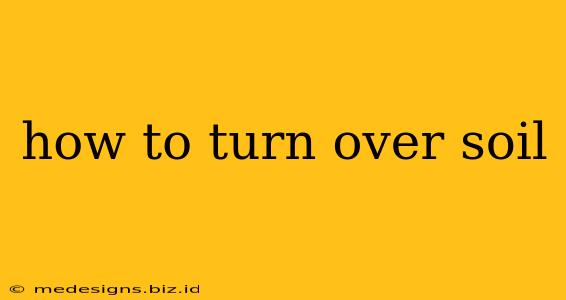Turning over your soil, also known as double digging or soil tilling, is a crucial step in creating a thriving garden. It's more than just flipping dirt; it's about improving soil structure, aeration, drainage, and nutrient availability for your plants. This comprehensive guide will walk you through the process, from choosing the right tools to understanding the benefits.
Why Turn Over Soil?
Before we dive into the how, let's understand the why. Turning over soil offers numerous advantages for your garden:
- Improved Drainage: Compacted soil hinders water penetration, leading to waterlogging and root rot. Tilling breaks up compacted areas, allowing for better water drainage.
- Enhanced Aeration: Air is essential for healthy root growth. Turning the soil introduces oxygen to the roots, promoting vigorous plant development.
- Increased Nutrient Availability: Tilling helps mix organic matter like compost into the soil, making nutrients more accessible to plants.
- Weed Control: Turning the soil buries weed seeds and reduces their chances of germination.
- Better Soil Structure: Tilling improves soil structure by creating a crumbly texture that's ideal for root penetration and water retention.
Choosing the Right Tools for the Job
The tools you choose will depend on the size of your garden and the type of soil you're working with. Here are some common options:
- Spade/Shovel: A good quality spade or shovel is essential for digging and turning over the soil. Choose one that's comfortable to hold and has a sturdy blade.
- Fork: A garden fork is ideal for loosening and aerating heavy clay soil. Its tines penetrate the soil more easily than a spade.
- Trowel: For smaller areas or delicate plants, a trowel can be very helpful.
- Gardening Gloves: Protect your hands from blisters and soilborne pathogens.
- Wheelbarrow (optional): If you have a large area to till, a wheelbarrow will help you move the soil efficiently.
How to Turn Over Soil: A Step-by-Step Guide
1. Prepare the Area: Clear the area of any debris, rocks, or weeds.
2. Mark Out Sections: Divide the area into manageable sections. This will make the process less overwhelming.
3. Dig and Turn: Using your spade or fork, dig into the soil to a depth of about 12 inches (30 cm). Turn the soil over, bringing the bottom layer to the top. Mix in any compost or other organic matter as you go.
4. Break Up Clods: Once the soil is turned, break up any large clods with the back of your spade or a garden fork.
5. Rake and Level: Use a garden rake to level the soil and remove any remaining debris.
Tips for Success
- Timing is Key: The best time to turn over soil is in the fall or early spring. This allows the soil to settle and the organic matter to decompose before planting.
- Soil Type Matters: The technique you use will vary depending on your soil type. Clay soil requires more effort to break up than sandy soil.
- Don't Overdo It: Over-tilling can damage soil structure and harm beneficial soil organisms. Aim for a gentle turnover.
- Consider No-Till Gardening: For some gardeners, no-till gardening is a better option. This method focuses on adding organic matter to the surface and minimizing soil disturbance. It's particularly beneficial for maintaining soil health in the long term.
Maintaining Healthy Soil
Turning over your soil is a significant step, but it's just one part of maintaining a healthy garden. Regular mulching, composting, and crop rotation will all contribute to long-term soil health and improve your gardening success. By following these steps and tips, you'll be well on your way to a thriving and productive garden.
